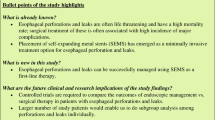Abstract
Background
Esophageal perforations and extensive anastomotic leaks after esophageal resection or gastrectomy are surgical emergencies with high mortality rates. In recent years, the use of self-expanding metallic stents (SEMS) has emerged as a promising treatment alternative for bridging and sealing the damage. This study aimed to evaluate the role of covered SEMS for the management of esophageal perforations and anastomotic leaks.
Methods
All esophageal stent placement procedures (174 procedures for 157 patients) at the authors’ unit between January 1999 and April 2008 were assessed by a retrospective chart review. Of the 157 patients, 10 (6.4%) were treated with SEMS for sealing of an iatrogenic esophageal perforation (n = 4), a spontaneous esophageal rupture in Boerhaave’s syndrome (n = 4), or an anastomotic leakage (n = 2).
Results
The median time from perforation or anastomotic leak to stent insertion was 13 days (range, 2 h to 48 days). The esophageal leak was totally sealed for 8 (80%) of 10 patients. The overall mortality rate was 50% (n = 5), and three (30%) of the five deaths were related to the perforation (n = 2) or leakage (n = 1). In both of the perforation cases, the diagnosis and treatment were substantially delayed. One patient with an anastomotic leak after gastrectomy died of the complication despite successful operative and SEMS treatment. Two of the deaths were unrelated to the perforation. In both cases, the cause of death was a disseminated malignant disease.
Conclusions
Traumatic perforations and anastomotic leaks can be treated effectively with covered SEMS together with adequate drainage of the thoracic cavity even in cases of severely ill patients with inveterate esophageal perforations and leaks.
Similar content being viewed by others
References
Baron TH (2001) Expandable metal stents for the treatment of cancerous obstruction of the gastrointestinal tract. N Engl J Med 344:1681–1687
Fischer A, Thomusch O, Benz S, von Dobschuetz E, Baier P, Hopt UT (2006) Nonoperative treatment of 15 benign esophageal perforations with self-expandable covered metal stents. Ann Thorac Surg 81:467–472
Mason GR (2001) Esophageal perforations, anastomotic leaks, and strictures: the role of prostheses. Am J Surg 181:195–197
Nesbitt JC, Sawyers JL (1987) Surgical management of esophageal perforation. Am Surg 53:183–191
Tilanus HW, Bossuyt P, Schattenkerk ME, Obertop H (1991) Treatment of oesophageal perforation: a multivariate analysis. Br J Surg 78:582–585
Johnsson E, Lundell L, Liedman B (2005) Sealing of esophageal perforation or ruptures with expandable metallic stents: a prospective controlled study on treatment efficacy and limitations. Dis Esophagus 18:262–266
Segalin A, Bonavina L, Lazzerini M, De Ruberto F, Faranda C, Peracchia A (1996) Endoscopic management of inveterate esophageal perforations and leaks. Surg Endosc 10:928–932
Amir AI, van Dullemen H, Plukker JT (2004) Selective approach in the treatment of esophageal perforations. Scand J Gastroenterol 39:418–422
Muir AD, White J, McGuigan JA, McManus KG, Graham AN (2003) Treatment and outcomes of oesophageal perforation in a tertiary referral centre. Eur J Cardiothorac Surg 23:799–804 discussion 804
Freeman RK, Van Woerkom JM, Ascioti AJ (2007) Esophageal stent placement for the treatment of iatrogenic intrathoracic esophageal perforation. Ann Thorac Surg 83:2003–2007 discussion 2007–2008
Gelbmann CM, Ratiu NL, Rath HC, Rogler G, Lock G, Scholmerich J, Kullmann F (2004) Use of self-expandable plastic stents for the treatment of esophageal perforations and symptomatic anastomotic leaks. Endoscopy 36:695–699
Siersema PD, Homs MY, Haringsma J, Tilanus HW, Kuipers EJ (2003) Use of large-diameter metallic stents to seal traumatic nonmalignant perforations of the esophagus. Gastrointest Endosc 58:356–361
Tuebergen D, Rijcken E, Mennigen R, Hopkins AM, Senninger N, Bruewer M (2008) Treatment of thoracic esophageal anastomotic leaks and esophageal perforations with endoluminal stents: efficacy and current limitations. J Gastrointest Surg 12:1168–1176
Schubert D, Scheidbach H, Kuhn R, Wex C, Weiss G, Eder F, Lippert H, Pross M (2005) Endoscopic treatment of thoracic esophageal anastomotic leaks by using silicone-covered, self-expanding polyester stents. Gastrointest Endosc 61:891–896
Siersema PD (2005) Treatment of esophageal perforations and anastomotic leaks: the endoscopist is stepping into the arena. Gastrointest Endosc 61:897–900
Griffin SM, Lamb PJ, Shenfine J, Richardson DL, Karat D, Hayes N (2008) Spontaneous rupture of the oesophagus. Br J Surg 95:1115–1120
Sawyer R, Phillips C, Vakil N (1995) Short- and long-term outcome of esophageal perforation. Gastrointest Endosc 41:130–134
Hunerbein M, Stroszczynski C, Moesta KT, Schlag PM (2004) Treatment of thoracic anastomotic leaks after esophagectomy with self-expanding plastic stents. Ann Surg 240:801–807
Langer FB, Wenzl W, Prager G, Salat A, Miholic J, Mang T, Zacherl J (2005) Management of postoperative esophageal leaks with the Polyflex self-expanding covered plastic stent. Ann Thorac Surg 79:398–403 discussion 404
Author information
Authors and Affiliations
Corresponding author
Rights and permissions
About this article
Cite this article
Salminen, P., Gullichsen, R. & Laine, S. Use of self-expandable metal stents for the treatment of esophageal perforations and anastomotic leaks. Surg Endosc 23, 1526–1530 (2009). https://doi.org/10.1007/s00464-009-0432-4
Received:
Revised:
Accepted:
Published:
Issue Date:
DOI: https://doi.org/10.1007/s00464-009-0432-4




